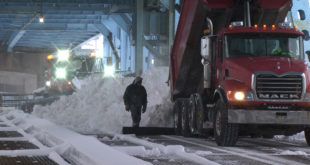The continuing battle against sea lampreys soon will come to locations in the local area.
A U.S. Fish and Wildlife Service assessment crew will conduct work in the Pilgrim River (Houghton County, MI) during June 16 – 22, 2017 to estimate the abundance of sea lampreys.
The information gathered will be used to determine the need for sea lamprey control.
A first step in the control of sea lampreys is to survey streams tributary to the Great Lakes to determine the presence of lamprey larvae. Sea lampreys invaded the Great Lakes during the 1920’s and have been a permanent, destructive element of the fishery ever since. Sea lampreys attach to fish with a suction cup mouth, rasp a hole though the fish’s scales and skin, and feed on blood and body fluids. The average sea lamprey will destroy up to 40 lbs. of fish during its parasitic phase.
Sea lamprey larvae hatch from eggs laid by adult lampreys in gravel nests, and drift into silty bottom areas where they burrow and live for several years. Also, larvae sometimes drift out of streams and settle in the immediate offshore areas near stream mouths. F ailure to detect and subsequently eliminate larvae allows the lampreys to transform into parasitic adults and kill Great Lakes fish.
Fishery biologists and technicians conduct surveys for sea lamprey larvae in hundreds of Great Lakes streams each year. Most surveys are conducted by electrofishing, but in deep waters crews use Bayluscide 3.2% Granular Sea Lamprey Larvicide, a lampricide approved by the U.S. Environmental Protection Agency and Health Canada Pest Management Regulatory Agency. This lampricide is specially formulated onto sand granules and covered with a time-release coating. The formulation is sprayedover a measured surface area of water where it sinks to the bottom, rapidly dissolves, and causes the larval sea lampreys to leave their burrows and swim to the surface where they are collected.
The U.S. Environmental Protection Agency and Health Canada Pest Management Regulatory Agency have reviewed human health and environmental safety data for the lampricides, and in 2003 concluded that Bayluscide poses no unreasonable risk to the general population and the environment when applied at concentrations necessary to detect larval sea lampreys. Applications are conducted in accordance with State of Michigan permits.
The sea lamprey control program is formulated and implemented by the Great Lakes Fishery Commission, in partnership with the U.S. Fish and Wildlife Service, Department of Fisheries and Oceans Canada, U.S. Army Corps of Engineers, and U.S. Geological Survey. The Commission initiated chemical control of sea lampreys in 1958. Since that time the highly successful program has contributed significantly to the maintenance of the $7 billion Great Lakes sport and commercial fisheries.
The Commission is committed to delivering a sea lamprey control program that practices good environmental stewardship. To support the continued safe use of lampricides the Commission recently conducted a series of studies at a total cost of $6 million to assess the effects of the lampricides on human health and the environment. In addition to these studies the Commission has implemented a research program to develop alternative control techniques. The Commission also is developing a strategy to increase the number of barriers on sea lamprey-producing streams, and is conducting research into barrier design, traps, attractants, and biological control.
For additional information in the U.S. call 1-800-472-9212 and in Canada call 1-800-553-9091. TTY users may reach the Marquette or Ludington Biological Stations through the Michigan State Relay Service at 1-800-649-3777.
The mission of the U.S. Fish and Wildlife Service is working with others to conserve, protect and enhance fish, wildlife, plants and their habitats for the continuing benefit of the American people. We are both a leader and trusted partner in fish and wildlife conservation, known for our scientific excellence, stewardship of lands and natural resources, dedicated professionals and commitment to public service.
For more information on our work and the people who make it happen, visit http://www.fws.gov.
Connect with our Facebook page at facebook.com/usfwsmidwest, follow our tweets at twitter.com/usfwsmidwest, watch our YouTube Channel at youtube.com/usfws and download photos from our Flickr page at flickr.com/photos/usfwsmidwest.
 Keweenaw Report Your Source for Local News and Sports
Keweenaw Report Your Source for Local News and Sports





